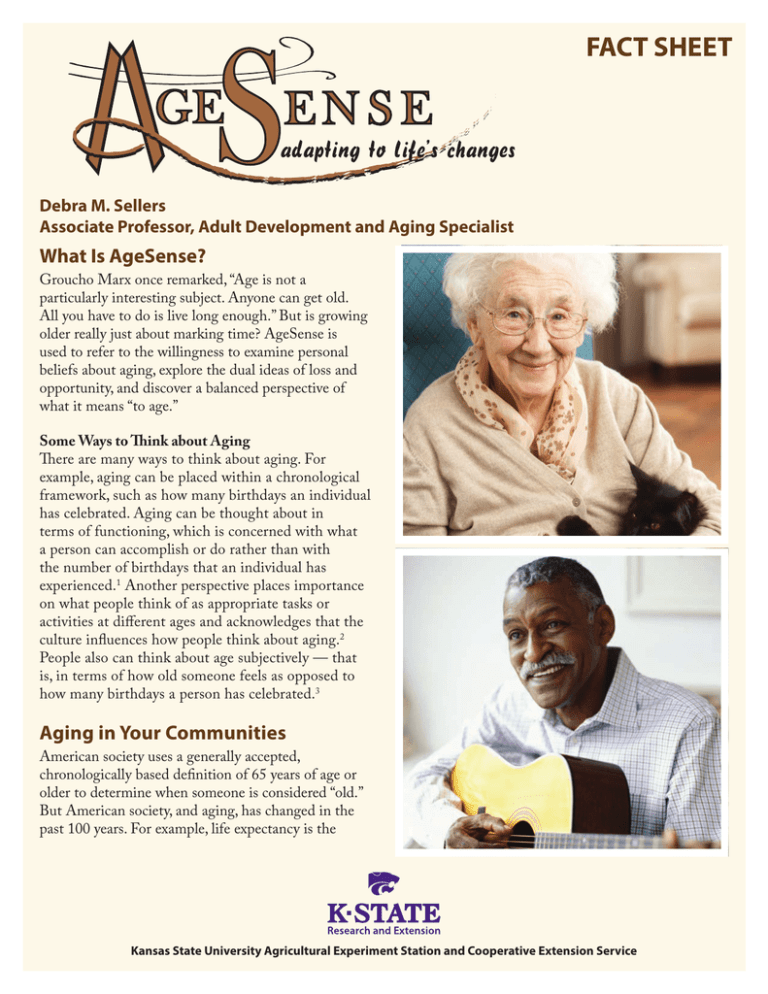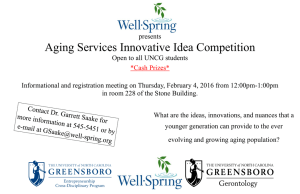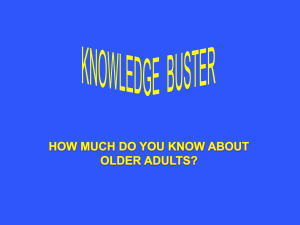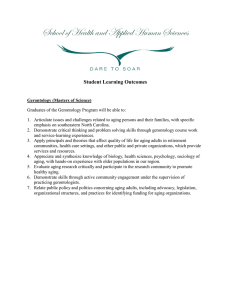
s
FACT SHEET
ge e nse
adapting to life’s changes
Debra M. Sellers
Associate Professor, Adult Development and Aging Specialist
What Is AgeSense?
Groucho Marx once remarked, “Age is not a
particularly interesting subject. Anyone can get old.
All you have to do is live long enough.” But is growing
older really just about marking time? AgeSense is
used to refer to the willingness to examine personal
beliefs about aging, explore the dual ideas of loss and
opportunity, and discover a balanced perspective of
what it means “to age.”
Some Ways to Think about Aging
There are many ways to think about aging. For
example, aging can be placed within a chronological
framework, such as how many birthdays an individual
has celebrated. Aging can be thought about in
terms of functioning, which is concerned with what
a person can accomplish or do rather than with
the number of birthdays that an individual has
experienced.1 Another perspective places importance
on what people think of as appropriate tasks or
activities at different ages and acknowledges that the
culture influences how people think about aging.2
People also can think about age subjectively — that
is, in terms of how old someone feels as opposed to
how many birthdays a person has celebrated.3
Aging in Your Communities
American society uses a generally accepted,
chronologically based definition of 65 years of age or
older to determine when someone is considered “old.”
But American society, and aging, has changed in the
past 100 years. For example, life expectancy is the
Kansas State University Agricultural Experiment Station and Cooperative Extension Service
number of years, on average, that people can expect
to live, given that they are born in a specific year. In
1900, life expectancy at birth was 47 years of age. In
1950, that number had risen to 68 years of age.4 And
in 2020, the average life expectancy projection at birth
is about 80 years of age — 77 for men and almost 82
for women.5 James Vaupel, an expert in the field, talks
about how life expectancy has increased by about 6
hours a day in the last two centuries.6
There are also other societal changes. In 1900, only
about 4 percent of individuals in the United States
were 65 years of age or older. In 2010, those 65
and older constituted about 13 percent of the total
population.7 In 2025, that number is expected to rise
to almost 18 percent, and in 2050, it is expected to
rise to approximately 20 percent of the total American
population.8
One group of researchers suggests that negative
attitudes and behaviors directed at older adults are
caused by fears related to aging and death.13 In this
view, aging is seen as a process of becoming less of
a person. Wrinkles, gray hair, liver spots, forgetting
names, losing driving privileges, using a wheelchair,
and a “bad” death may be used as examples of what it
means to age. This negative view of aging is centered
on the idea of loss.14-15
The population of Kansas mirrors national population
numbers. In 2010, a little more than 13 percent of the
entire population in Kansas was age 65 or older 9 and
by 2030, 20.2 percent of Kansans will be age 65 or
older.10
Another view may be categorized as “anti-aging,”
with a goal of retaining youth.16 Although an
acknowledgment is given that chronological years are
advancing, aging is seen as preventable, and old age as
a fight that can be won. This view may include denial
and a refusal to think about the possibility of disease,
frailty, dependence, and the certainty of death.17-18
Rather than becoming less of a person, individuals
have the opportunity to, as Oprah Winfrey put it, “age
brilliantly.”19
In the past, when life expectancy was so much less than
it is today, people didn’t have much of a chance to die
from Alzheimer’s disease or stroke. These diseases are
prominent today because societal and medical advances
have been successful at preserving life into those older
age ranges. In earlier times, men, women, and children
might die from a variety of acute illnesses.11 People
didn’t live long enough, for the most part, to acquire
long-term chronic diseases. Another contributing
factor is that women started having fewer children,
which affected the number of younger people present
in society. All of these changes are relatively new
within the context of all of human history.
Ageism refers to an irrational prejudice similar to
racism or sexism.20 Beliefs can center on negative
views of aging, or they can fall into excessive
positivism. The United States currently tends to lean
toward mostly negative attitudes and stereotypes,21
and younger adults tend to have a more negative
attitude about their own aging than do older
adults.14;22 Numerous beliefs Americans hold about
aging are actually false.23 For example, older adults
report better well-being than younger adults, with a
possible peak during the seventh decade of life.24-25
Additionally, people seem to gain in wisdom as they
age.26 There both losses and gains to aging.
Society is just in the beginning stages of thinking
about and understanding old age in modern terms.
This rapid aging of the population has helped create
attitudes and stereotypes about older adults and what it
means to grow older.12
Stereotypes
Ideas about aging help formulate the attitudes people
have about growing older. Attitudes can be both
negative and positive, and within the realm of aging,
both of these stereotypes exist.
2
Why Change Attitudes about Aging?
Model of Selective Optimization with
Compensation (SOC)
American society is aging, and many individuals have
negative attitudes and hold false beliefs about growing
older. People who think positively about their own
aging actually do more for their own health.27 They
also tend to report they are more functional,28 more
likely to recover from disability,29 and more likely to
live longer.30 Additionally, researchers have suggested
that changing the way American society views aging
may help reduce and prevent declines in function and
consequences associated with those declines.31
One way to think about aging is as another stage
in life’s journey. People experience losses and gains
throughout their lifetimes, not just during old age. This
concept and other important points related to aging
are illustrated in the Model of Selection, Optimization,
and Compensation (SOC).35-36
Selection refers to choosing activities and goals, a
process that happens throughout people’s lives. People
select certain goals as children, young adults, middleaged adults, and as they grow older. When they
choose one goal over another, they are missing out on
other opportunities.
Education can reduce ageism, as those who have more
knowledge about the aging process hold less negative
attitudes about aging.23; 32 By ensuring that beliefs
about aging are accurate, individuals and society may
benefit. Beliefs influence how people act toward each
other and what programs and services they choose to
support.33-34
Optimization means simply that there are certain
behaviors needed to achieve those goals in order to
be successful. Optimization refers to the means that
people use to achieve the selected goal.
Compensation is used when the means or behaviors
that a person was using to achieve a goal are no longer
available. There has been a loss in some way, and a new
strategy is needed to keep that goal alive.35; 37-38
SOC implies that success includes maximizing
positive outcomes, minimizing challenges, and using
the three functions of S, O, and C. This is true for
children, adolescents, young adults, middle-aged
adults, and older adults. What are selected as goals,
how resources are optimized, and when compensatory
strategies are used are different across the lifespan. The
distribution may change, and what is actually defined
as a “gain” (desirable outcomes) or a “loss” (avoidance
of undesirable outcomes) might be different. The
model acknowledges that there are biological changes
inherent within the aging process, but that the aging
process differs across individuals because of genetics
and lifestyle.35
SOC also suggests that culture has an important
role to play in the aging process. For example, the
development of hearing aids has helped people with
hearing deficits function better in society and remain
independent. This is an example of how culture, in
terms of a technological invention, can intervene to
help people with a biological loss. If an individual
chooses to use a hearing aid, then he or she is using the
technique of compensation.36
3
A classic example used to explain SOC may be found
within the story of pianist Arthur Rubinstein. At age
80, when asked how he could still be so proficient in
his piano playing, he said that he carefully chose just a
few pieces (selection). He practiced these fewer pieces
more often (optimization). And, because he couldn’t
play the faster parts as fast as he used to, he slowed
down even more in the slower parts, which made the
fast parts seem faster (compensation).
SOC gives people a way to respond to everyday
demands in an adaptive manner, taking into account
biology and culture.35 With SOC, it is all about
balancing gains and losses. Individuals can achieve a
balance through thinking about the goals selected, the
behaviors they chose to engage in, and the strategies
used to compensate when needed. By using SOC,
people can adapt.
Using SOC to Change
Your Thinking about Aging
SOC suggests that people use selection, optimization,
and compensation throughout their lives, even though
they don’t always realize this is what they are doing.36
Setting goals, figuring out how to achieve the desired
outcome, and finding another way when presented
with some obstacle may be viewed by others as
adaptive when this takes place in earlier life stages.
But in the face of societal and personal stereotypes
about aging, many people lose sight of this fact.35-36; 38
The SOC model suggests that people who are aging
may continue to use the three functions of selection,
optimization, and compensation to choose important
goals, figure out how to get to that goal, and change
tactics along the way if needed.37
Summary
Apart from the number of birthdays a person has
experienced, there are many ways to think about the
process of growing older. American society tends to use
a chronologically based definition of 65 years of age to
determine what constitutes an “older adult,” although
people are beginning to think about what it means to
Publications from Kansas State University are available at: www.ksre.ksu.edu
Publications are reviewed or revised annually by appropriate faculty to reflect
current research and practice. Date shown is that of publication or last revision.
Contents of this publication may be freely reproduced for educational purposes.
All other rights reserved. In each case, credit Debra Sellers, AgeSense: Adapting to
Life’s Changes, Fact Sheet, Kansas State University, August 2013.
age in the 21st century. Currently, attitudes about aging
fall on a continuum of negative to positive, although
most Americans tend to hold generally negative beliefs
and stereotypes. By examining personal attitudes and
learning more about aging, people may decide that
although aging is inevitable, a negative attitude about
the process is not. People who think more positively
about their own aging may reap many benefits, such as
the possibility of living longer.
The Model of Selective Optimization with
Compensation offers a way to think about growing
older as another stage of life with both losses and
gains and to discover ways to adapt to the aging
process. Individuals can achieve a balanced view of
aging through thinking about the goals they select,
the behaviors they engage in, and the strategies they
use to compensate when needed. Within this model,
living life as an older adult can be viewed as a familiar
adaptive process of balancing losses and gains.
*Note: For a list of references cited in this document,
please visit www.aging.ksu.edu/p.aspx?tabid=203.
Information
Joan Kahl, jkahl@ksu.edu
Extension Associate, FCS
Kansas State University School of Family Studies and
Human Services
www.aging.ksu.edu
Kansas State University Agricultural Experiment Station and Cooperative
Extension Service
K-State Research and Extension is an equal opportunity provider and employer.
Issued in furtherance of Cooperative Extension Work, Acts of May 8 and June
30, 1914, as amended. Kansas State University, County Extension Councils,
Extension Districts, and United States Department of Agriculture Cooperating,
John D. Floros, Director.
MF3079
August 2013



